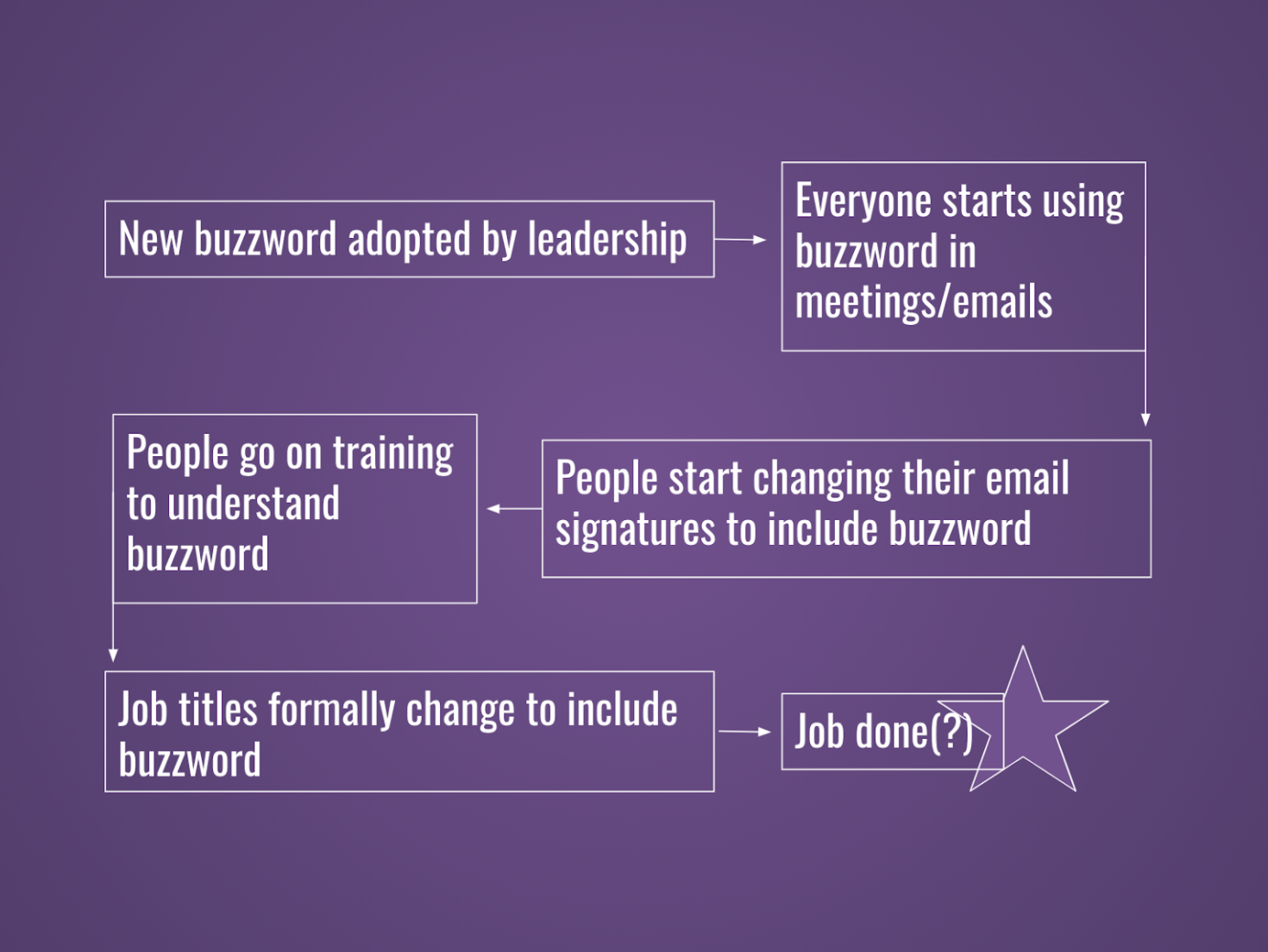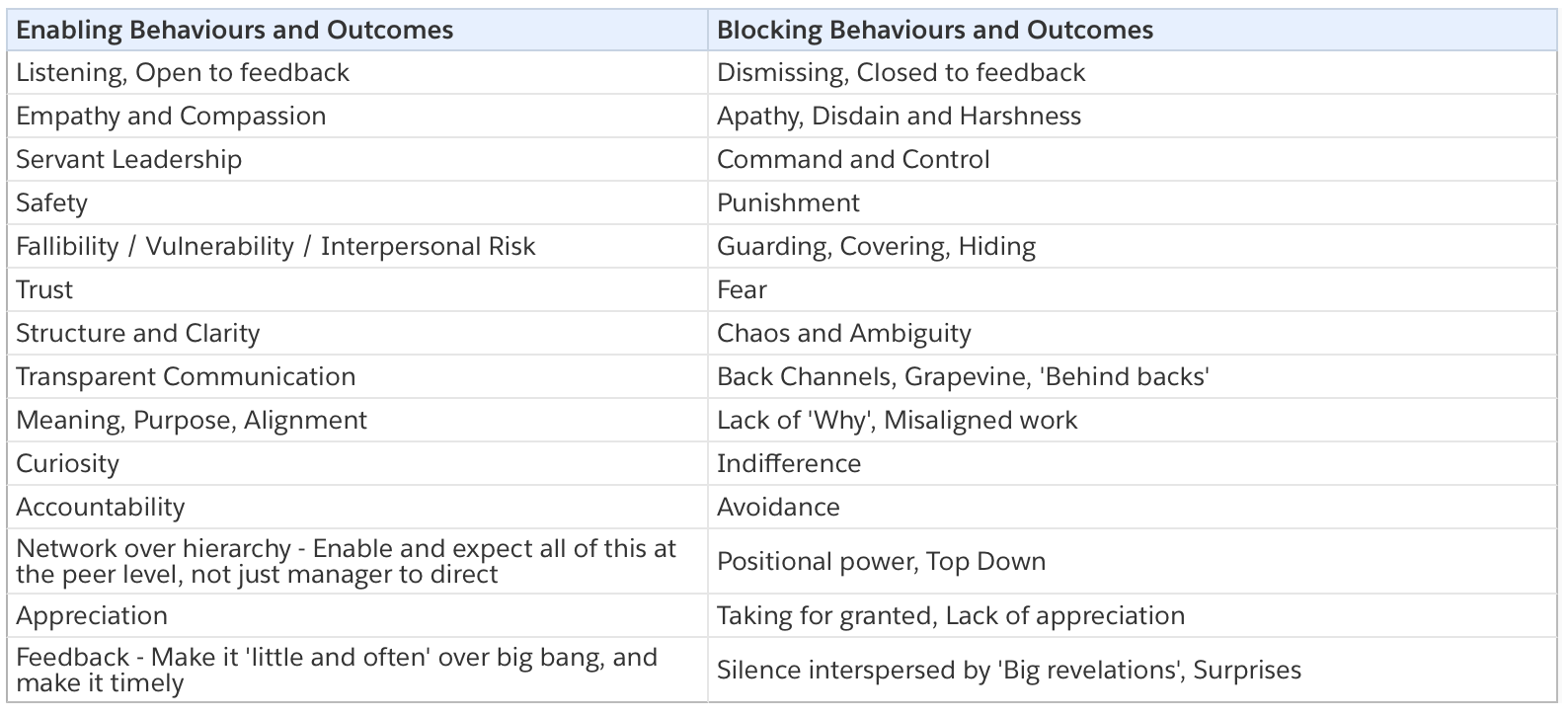It is comforting to see that we are in an age where Psychological Safety has become ubiquitous, and synonymous with high performing teams. Amy Edmondson in her research over the years has popularised the term, and her TEDx talk gave us an early insight into the power of it. I’d urge everyone interested in the subject to read The Fearless Organisation - it’s a superb work that talks about the what, why and how of Psychological Safety. Googles’ Project Aristotle in 2012 then helped elevate the stage a little after finding Psychological Safety as the missing link in helping to define what makes a high performing team.
But this post isn’t about the ‘what’ or ‘why’ behind Psychological Safety - there are so many other posts on the internet about that. I’ve been very lucky to talk to people across multiple organisations, sectors, and backgrounds over the past few years on this topic, and I will distil some of my thoughts in this article.


I wanted to explore both the meteoric rise in the subject, and a worrying trend that I see happening with the term that mirrors the Diffusion of Innovation curves that we’ve seen with the likes of Agile and DevOps.
A rise in interest is not a bad thing! Early on with any awareness/adoption you will appeal to a small number. Agile appealed to a set of stalwarts around software engineering and improving practices in an attempt to move away from what had come before (Waterfall etc.). Over time, popularity builds, and we start to see the topic brought into more and more conversations. We see the rise of frameworks, we see people selling services, we see adoption and normalisation of the terms within it. At this point, the topic will take on a life of its’ own. Large consultancies will help you get there, software tools will help you measure it and deliver it, books and training courses will help you learn it. It becomes a self fuelling industry.
The growth of Agile and DevOps over the past 10 years following that trend of popularisation into monetisation is very real, and has turned both Agile and DevOps into multi-million pound industries.
The Rise (and Weaponisation) of Psychological Safety
What we have started to see over the past few years is the same adoption and growth in Psychological Safety. It has become a poster child, as did Agile and DevOps in their own spaces, and it is becoming the thing everyone talks about.
It’s great that it is talked about, and no bad thing that organisations are becoming more aware - the literature is vast, and the evidence is mounting - Psychological Safety is pivotal to high performance within teams.
So what is the problem? If all it does is feature in conversations, we are missing the value that comes from the behaviour changes that follow. What we have seen with Agile and DevOps across many industries over the past 10 years is something akin to the this flowchart.

On talking to many organisations, it seems these same steps can also be said of Psychological Safety. You see it pushed into the common vernacular. It becomes the word that no meeting can be without. People talk about the power behind it, they learn it. And then it all stops and becomes ‘the thing we’re now doing’, except we’re not. We’ve merely weaponised it enough to make it go away.
The danger in talking and not doing
Psychological Safety is hard. Raising concerns, ideas or feedback, bringing challenge, conflict and healthy debate to the table - these are all really difficult. Interpersonal risk and vulnerability is a key component within Psychological Safety behaviour change, and it is very much a ‘we’ problem that lives with every employee. Managers can amplify and make easier the behaviour change, but it still requires people to step up.
The dangers of not turning the discussion into action are well documented in the literature - the VW emissions scandal, the failed columbia mission, the many airline crashes, Wells Fargo, and many more - awareness of the topic does not inherently make the environment safe, and in worst cases can lead to death.
How can you make your organisation different?
I’m very lucky to be involved in a rollout of Psychological Safety within my own organisation, and it has been great to see the mounting interest in the subject over the past few years, and the buy in from leadership into it being something they tangibly want to work towards. They understand that Psychological Safety is pivotal to a High Performing Culture, and actively want to take behaviour change and steps to get closer to it. I’ll share the pathway we’re on in the hopes it helps teams or organisations who are interested in turning the theory into practice.
We have kept this rollout as an exercise in learning and adapting - we didn’t involve consultants, we didn’t buy any off the shelf products - we have taken a simple pattern (similar to PDCA or OODA) and broken our program into a four step approach.
- Learning and Discovery - you cannot start on the journey towards Psychological Safety without first understanding the subject and the impact. We deliver a talk around the ‘why’, the ‘what’ and the ‘how’. Everyone within their various teams learns together, and is encouraged to talk about that learning. We amplify this message for leaders.
- Measure - using Amy’s 7 question survey that is linked in so much of the literature in the resources at the bottom of this slide. Ensure it is anonymous. You have to have trust in place to get honest answers, and the anonymity of it is important. Share the results with the teams, be transparent
- Reflect and Plan - both at the leadership level, and within the teams - start to look for one or two key areas to improve over the coming quarter. What would make it easier to take risks on the team? How can we help staff better utilise their skills and talents? Make the solution to this inclusive.
- Improve - bring that plan into the coming quarters work. The focussed behaviour changes that we wish to see, those tangible actions that we all can take. Make the conversation on the subject ongoing. Leaders can amplify and increase this message throughout the improve phase.
This is a repeating cycle, and each quarter, we will continue the cycle - maximising awareness, understanding where we are, talking about our position and where we want to focus, and then the most important step - the improvement. Those tangible behaviours, signals and steps towards making it safe to raise ones voice, to come forward, and to bring our best selves to this VUCA world most of us now inhabit.
Leadership Behaviours to amplify Psychological Safety
Our position as leaders - be it middle managers, senior, or c-suite is outsized when it comes to behaviour change within Psychological Safety. It is not solely our job as we highlight above - it is a ‘we’ problem within any organisation, but we often have positional authority that can help our teams see results from the behaviour change required within Psychological Safety far more easily.
- “It’s always on the leader to go first” - what our teams do day to day is mission critical within our space - our teams would not exist if it were not so. We have to model the behaviours that allow them to follow, we have to be willing to be first into the arena, we have to be willing to be vulnerable, and we have to model the behaviours we wish to see.
- Create the environment - what is your organisational culture? It could be said “culture is what happens when the boss isn’t there”, or “the culture of your organisation is defined by the worst behaviours you are willing to tolerate”. These are both true. You have the ability to create an environment of good practice.
- Amplify our teams - managers do not directly create value within an organisation, they amplify it, and they enable (or detract from) it - our teams are at the store front, the coal face, the assembly line - they are the ones building in the value. Consider how you are amplifying their voice and their work.
- Invite and encourage participation - there are many approaches here, start in 1:1s, invite individuals to talk in group sessions, model curiosity and ask questions. In the uncertain and complex world of work, we have to bring all voices and all brains to the table.
- Seek (and give) feedback readily - feedback is essential to high performance. Think ‘small and often’ rather than ‘big bang’, and seek it out first to build trust. It is incredibly powerful to see a good feedback system in place in a team, and the team perform better for it.
- Be the last to speak - positional authority is a reality. Focussing on listening, with a light touch towards steering in the day to day will get the most from your teams’ voices. What you say has impact, and you will likely have a great deal more context about the strategic, the vision, and the wider context and you can bring that to the table, but avoid being the first to speak in meetings - it silences voices and ideas.
- Be secure in your vulnerability - when a great deal of the practice in Psychological Safety involves interpersonal risk and stepping into the arena - saying “I don’t know” or “I screwed this up”, being comfortable with your own vulnerability and modelling it makes it so much easier for your teams to do the same.
- Set expectations - feedback/candor, voices, respect, outcomes - this isn’t, just about being ‘nice’ - raise the bar on your expectations of the team around them bringing their voices to the table.
- Default to trust - it is harder for someone without positional authority to trust. That trust has to be earned. You have to blessed position of being able to start with trust with your teams. They are there with best intent to do a good job, and if you default to a position of trust, it will make behaviour change so much more rapid.
- Make relationships more than just work -
treat others how you want to be treated.treat others how they would like to be treated. We all of us have a lot more going on than our next project - talk to your team as humans, care personally about them - it makes it so much easier to build up an environment of healthy debate and challenge. - Appreciation - it doesn’t have to be grand gestures - we all have things to be thankful of with our team, show it with praise.
- Be available - “My door is always open”, except when it’s not and you’re in back to back meetings. Make time for the team, make sure they are aware they are a priority, and that you will be there for them.
A lot of this seems to be about being ‘nice’. It is. But we are managers, and we also have responsibility within our roles to ensure the performance of our team, to handle discipline, to have meaningful conversation around accountability etc. - none of the other parts of our job go away or change.
Enablers and Blockers to Achieving Psychological Safety
This list is nothing more than a short collection of things that help the journey towards behaviour change with Psychological Safety, or can act as fundamental blockers to ever achieving it. Consider each of these, look at behaviours in the team - look at team rituals (daily stand ups, 1:1s, retrospectives, etc.) and how these behaviours manifest. The more of the left column you can demonstrate, the more likely the environment will be to have an underpinning of Psychological Safety.

Turn YOUR journey into more than a conversation
Where are you on this journey? Have to read a book or a blog post on the subject? Have you gone as far as having your team measure psychological safety using Amy’s survey?
Have you gone past just talking and measuring?
The hard work starts directly after learning and measuring. Once you have an understanding of your teams’ Psychological Safety, the next steps are overwhelmingly difficult. The rewards are huge, and the mounting evidence backs it up - companies that focus in on culture had a 756% net revenue growth over those that didn’t in a harvard study. We have seen Pixars monumental box office success which Ed Catmull attributes to the brain trust, a model for Psychological Safety.
The behaviours above, coupled with those in Amy’s book, and the research below can get you on the right track.
Turn the discussion into action, bring courage to the table, and create an environment everyone wants to work in.
Resources
A number of sites that I’ve gathered with a lot of the ‘how’ behind Psychological Safety. If you do only one thing, read Amy Edmondson’s book listed above. If you are exploring the topic, the resources below all had something in them that I thought was interesting.
- Psychological Safety: Models and Experiences
- 7 ways to create psychological safety in your workplace
- 9 Exercises to Promote Psychological Safety in Your Organisation
- 4 Practices to Foster Psychological Safety
- How to ensure psychological safety at work
- Building psychological safety
- 7 Ways to Promote Psychological Safety In Your Organisation
- Creating Psychological Safety - Put this into Practice
- Psychological safety first: building trust among teams
- How to create psychological safety at work
- Psychological Safety At Work: what do psychologically safe work teams look like?
- 4 Questions that Build Psychological Safety (Virtual Team Toolkit)
- How to Create a Culture of Psychological Safety
- Improving Psychological Safety at Work: A Five-Point Plan
- 3 Ways to Promote Psychological Safety in Your Team
- Successful Teams Practice Psychological Safety
- Psychological Safety - why it matters, and seven ways leaders can built it within their teams
- High-Performing Teams Need Psychological Safety. Here’s How to Create It
- Psychological Safety: The secret to Google’s top teams’ success - and 5 lessons for workplaces
- How To Create Psychological Safety In A Learning Environment
- How to Cultivate Psychological Safety for Your Team, According to Harvard Professor Amy Edmondson
- 8 ways to create psychological safety in the workplace
- 9 Strategies to Create Psychological Safety in the Workplace
- Psychological Safety: How to Build and Promote Team Psychological Safety